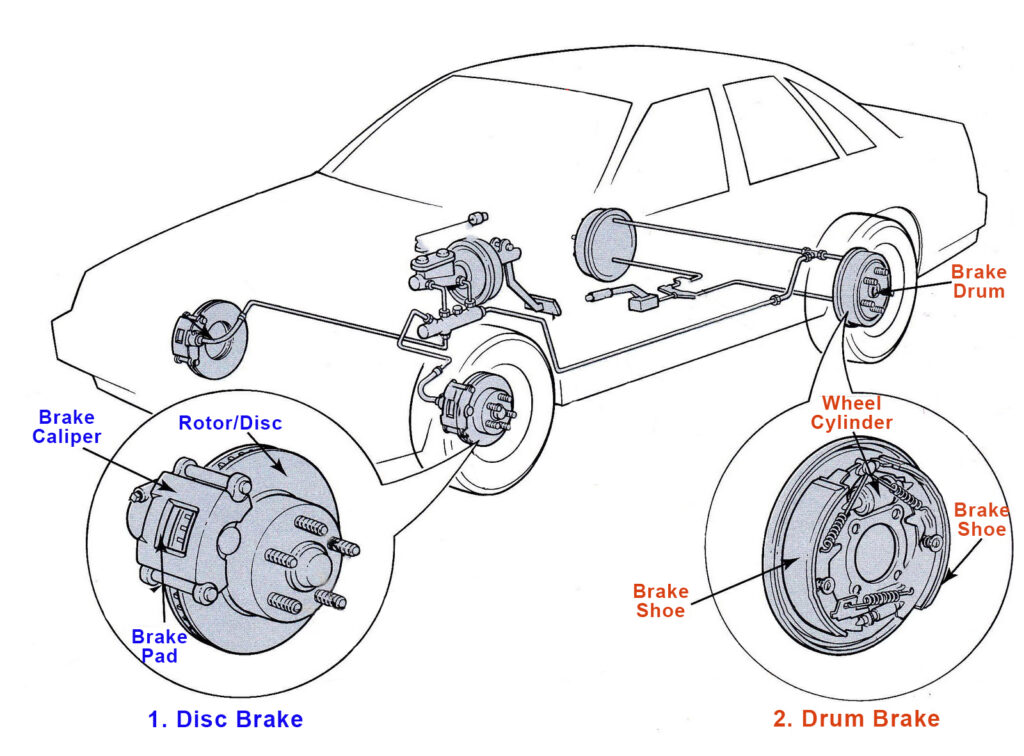Brake shoes play an instrumental role in enabling your vehicle to decelerate and come to a stop. Hidden within the wheel assembly, they work tirelessly every time you press the brake pedal, creating the necessary friction to slow down your vehicle’s wheels. As fundamental components of drum brake systems, they bear the enormous responsibility of helping maintain control of your vehicle and safeguarding the driver, passengers, and others on the road.
This article aims to shed light on these essential components – brake shoes. It delves into their role, how to identify when they need replacement, their lifespan, and ultimately, the impact on your vehicle’s safety and performance. Whether you’re a car enthusiast or a daily driver, enhancing your knowledge about brake shoes will lead to safer drives and better vehicle maintenance. So, let’s brake it down!
What do brake shoes do?

Brake shoes are crucial components of a vehicle’s braking system, specifically in drum brakes, which are often found in older or smaller cars, and usually located on the rear wheels of many modern cars.
When you press the brake pedal, you set in motion a sequence of events that leads to your vehicle slowing down or stopping. This action engages the brake master cylinder, which then transmits hydraulic fluid along the brake lines. This fluid, under pressure, reaches the wheel cylinders located in the brake drums.
Inside each brake drum are two brake shoes, one facing forward and one facing backward. These brake shoes are lined with friction material similar to what you would find on a disc brake pad. The hydraulic pressure from the brake fluid pushes these brake shoes outward against the inner surfaces of the brake drum.
The interaction between the brake shoes and the brake drum generates friction. This friction is what slows down the rotation of the wheels, and in turn, slows or stops the vehicle. Essentially, brake shoes work by converting the kinetic energy (the energy of motion) of your moving vehicle into thermal energy (heat) through friction.
Moreover, there are two types of brake shoes in a drum brake system: the primary (or leading) shoe and the secondary (or trailing) shoe. The primary shoe is typically smaller and faces the front of the vehicle, while the secondary shoe is larger and faces the rear. When the brakes are applied, the rotation of the drum pulls the primary shoe into the drum, which increases the force of friction and makes the braking more effective.
The design and positioning of the brake shoes allow for effective heat dissipation, minimizing the risk of brake fade – a condition where the brakes lose effectiveness due to overheating.
How many brake shoes does a car have?
In an automobile, the braking system is one of the most critical safety components, and brake shoes are an essential part of this system. Each brake shoe is a curved metal piece lined with a friction-causing material known as the brake lining.
The number of brake shoes in a car primarily depends on the type of braking system the vehicle has. Let’s break it down according to the two most common types:

- Four-Wheel Drum Brakes: Older or classic cars often feature drum brakes on all four wheels. Each drum contains two brake shoes, one on each side of the drum. That’s a total of eight brake shoes for the vehicle – two shoes per wheel, one for the forward part of the drum and one for the rearward part.
- Disc Front/Drum Rear Brakes: Most modern vehicles use a combination of disc brakes at the front and drum brakes at the rear. Disc brakes, unlike drum brakes, use brake pads and a brake caliper instead of shoes. Therefore, in this setup, you’d only find brake shoes on the rear wheels. Like the drum brake setup, each rear drum brake contains two shoes, resulting in a total of four brake shoes for the vehicle.
The brake shoes are forced outward against the inside of the drum by the wheel cylinder when the driver applies the brakes, creating friction that slows the vehicle down.
How often should brake shoes be changed?
The lifespan of brake shoes varies significantly based on various factors, including the driver’s habits, vehicle usage, the quality of the shoes, and driving conditions. Generally speaking, brake shoes can last anywhere between 35,000 to 60,000 miles. However, this is a rough estimate, and real-world conditions may necessitate more frequent replacements.
- Driving habits significantly affect the longevity of your brake shoes. For instance, frequent hard braking can cause the brake shoes to wear out faster. If you mostly drive in the city with heavy traffic, constant stop-and-go will exert more stress on your brakes, wearing out your brake shoes more quickly compared to highway or country driving where brakes are applied less often.
- The quality of the brake shoes also matters. High-quality brake shoes made from durable materials typically last longer than cheaper alternatives. Therefore, investing in good quality brake shoes can save you from frequent replacements.
- Driving conditions can also influence how often brake shoes need replacing. If you frequently drive in hilly, mountainous areas where more braking is required, the brake shoes may wear out faster. Similarly, driving in dusty or gritty conditions can also accelerate brake shoe wear, as small particles can get in between the brake drum and the shoe, increasing friction and wear.
- To determine if your brake shoes need replacement, look out for warning signs such as squeaking or squealing noises, a car that pulls to one side when braking, or a brake pedal that feels less responsive. Most vehicles also have a brake warning light on the dashboard that lights up when the brake system detects excessive wear.
For accurate evaluation and maintenance, regular brake inspections – typically recommended every 10,000 to 12,000 miles or at least once a year – are essential. During a brake inspection, a mechanic will measure the thickness of the brake shoe lining and check for any damage. If the lining is too thin or the shoe is damaged, replacement is necessary to maintain optimal braking performance and safety. It’s recommended to replace all brake shoes on the same axle at the same time to ensure even braking.
How do you know if your brake shoes are bad?

Identifying worn or bad brake shoes is critical for ensuring vehicle safety. Here are several signs that could indicate your brake shoes may need to be replaced:
- Noise: The most common sign of worn-out brake shoes is noise. When brake shoes wear thin, they may produce a scraping or grinding sound when the brakes are applied. This noise comes from the metal backing of the brake shoe rubbing against the metal brake drum.
- Pulling to one side: If your vehicle pulls to one side when braking, it could be a sign that the brake shoes are wearing unevenly or there may be a problem with one of the brake shoe assemblies. This uneven wear can be caused by a variety of factors including a maladjusted brake, seized wheel cylinder, or worn seal allowing brake fluid to contaminate the brake shoe.
- Less responsive brake pedal: If the brake pedal feels less responsive or “soft”, it could mean that your brake shoes are worn out. A less responsive brake pedal might also be indicative of a brake fluid leak.
- Increased stopping distances: Worn-out brake shoes may increase your vehicle’s stopping distance. If you notice that your car takes longer than usual to stop, it’s essential to have your brake shoes checked.
- Bad odor or smoke: An acrid burning smell or smoke coming from your wheels could be a sign that your brake shoes are severely worn or overheated. This is a serious condition that requires immediate attention as it could lead to brake failure.
- Warning light: Some vehicles have a brake warning light that will illuminate the dashboard if the vehicle’s diagnostic system detects a problem with the brake shoes.
Remember, these signs are warnings that there could be a problem with the brake shoes or another part of the brake system. If you experience any of these symptoms, it’s crucial to have your brakes inspected as soon as possible to ensure your vehicle is safe to drive. Regular brake inspections are the best way to ensure that your brake shoes are in good working condition and to catch any potential issues before they become serious problems.
In conclusion, understanding brake shoes, their importance, and their maintenance are essential for any vehicle owner. However, merely understanding these components is not enough – it’s equally important to choose the right brand that ensures quality, durability, and safety.

In a market saturated with various brake shoe offerings, GDST stands out due to its commitment to excellence and safety. With years of experience and expertise in the automotive sector, GDST delivers brake shoes that are designed to offer outstanding braking performance, enhance driving safety, and prolong the service life of your braking system.
GDST brake shoes are engineered with premium materials for maximum friction and heat resistance, ensuring reliable and effective braking. We adhere to rigorous testing standards, ensuring that our brake shoes meet and often exceed OEM specifications. In addition, our brake shoes are designed for an array of vehicle types, offering a wide range of options to cater to your specific needs.
Welcome to visit GDST Brake Shoes Manufacturer!


